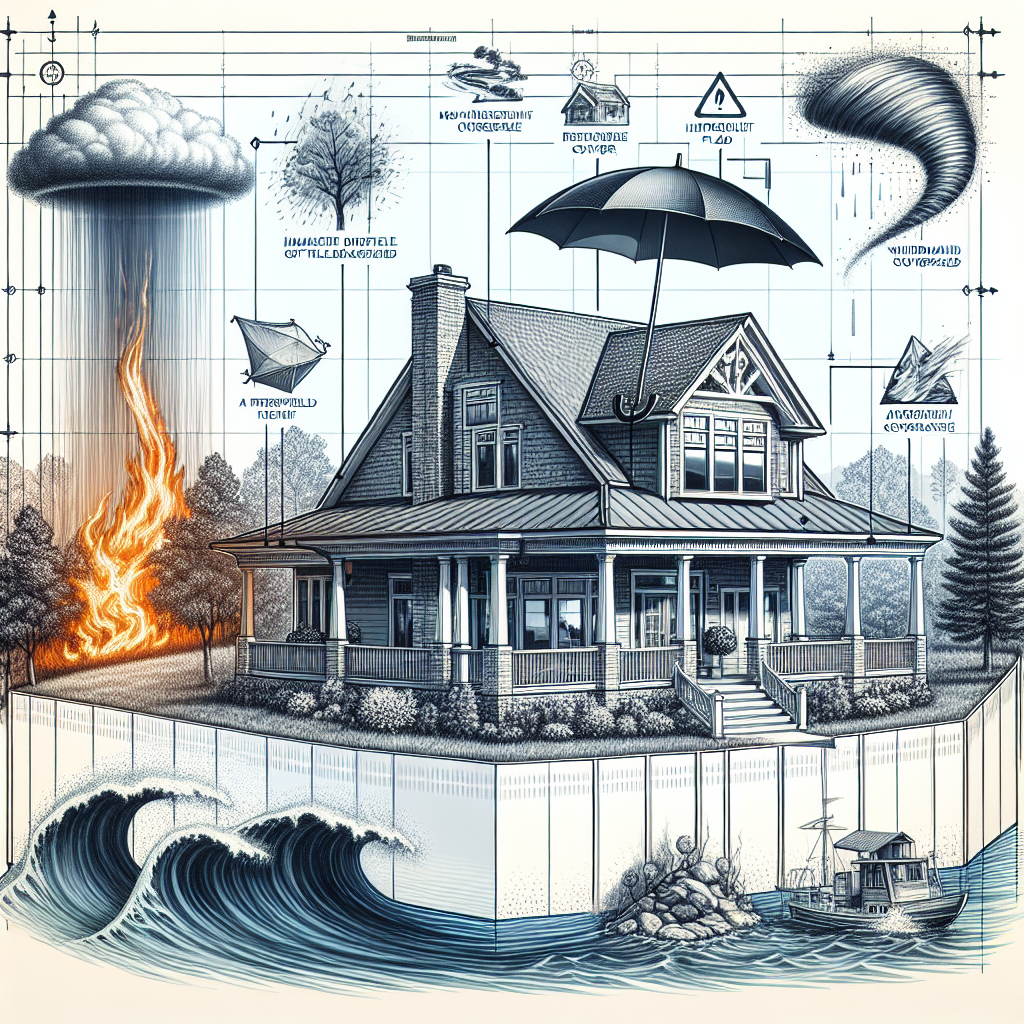Filed under Home Insurance on
VA Home Insurance Coverage: What It Covers and Costs

If you own a house in Virginia or plan to buy one, understanding VA Home Insurance Coverage is essential to protecting your finances and peace of mind. From coastal windstorms to winter ice and river flooding, the Commonwealth’s diverse geography creates a mix of risks that standard policies address in different ways. This guide explains what a typical policy covers, what it does not, how much it costs in Virginia, and the smart add-ons and savings strategies many homeowners use to tailor a policy that actually fits their life.
What VA Home Insurance Coverage Means in Virginia
In this article, “VA” refers to Virginia. Homeowners insurance in Virginia is a private policy that protects your house, belongings, and liability. It is not provided by the state, and it is separate from flood insurance or any lender-specific requirements. Insurers use Virginia’s risk data—coastal exposure, wildfire potential, crime rates, building costs, and claim trends—to set rates and underwriting rules.
Virginia vs. Veterans Affairs: Clearing Up the Common Confusion
Some shoppers searching for “VA Home Insurance Coverage” are thinking of Veterans Affairs. The U.S. Department of Veterans Affairs guarantees VA loans but does not sell homeowners insurance. If you use a VA-backed mortgage, your lender will require homeowners (hazard) insurance, and you’ll buy that from a private insurer just like any other homeowner in Virginia.
What a Standard Virginia Policy Typically Covers
Most Virginia homeowners purchase an HO-3 (special form) policy. Premium carriers may offer HO-5 (broader, open-perils on personal property), while older homes sometimes see HO-2 (named perils) options. Here’s what you usually get with a standard policy.
Core Protections
- Dwelling (Coverage A): Rebuilds or repairs your home if it’s damaged by a covered peril. Limits should reflect full replacement cost, not market price.
- Other Structures (Coverage B): Detached garages, fences, sheds—typically 10% of dwelling limit.
- Personal Property (Coverage C): Furniture, electronics, clothing. Default is actual cash value unless you upgrade to replacement cost coverage.
- Loss of Use (Coverage D): Pays for temporary living expenses (hotel, meals) if a covered loss makes your home uninhabitable.
- Personal Liability (Coverage E): Covers injuries or property damage you cause to others, on or off premises. Common starting limits are $300,000, with options to increase.
- Medical Payments to Others (Coverage F): No-fault medical coverage for guests injured at your home.
Covered Perils vs. Exclusions
HO-3 policies cover “open perils” for the dwelling—everything except what’s excluded—while personal property is usually “named perils” unless you upgrade. Typical covered risks include fire, wind, hail, theft, vandalism, weight of ice/snow, and sudden water discharge (like a burst pipe). Common exclusions:
- Flood (from storm surge, heavy rain overflow, or river rise)
- Earth movement (earthquake, landslide, sinkhole) unless endorsed
- Sewer or sump pump backup unless endorsed
- Wear and tear, neglect, or maintenance issues
- Mold or rot beyond limited coverage
- Power failure outside your property, unless resulting in a covered cause
Because hurricanes and nor’easters can drive coastal water inland, flood insurance is a critical add-on for many Virginians—especially along the Chesapeake Bay, the Potomac and James River corridors, and in low-lying neighborhoods.
Optional Add-Ons Virginians Often Consider
Every home is different. The most cost-effective VA Home Insurance Coverage is the one calibrated to your address, construction type, and lifestyle. Popular endorsements include:
- Flood Insurance: Available via the National Flood Insurance Program (NFIP) and private markets. Even outside high-risk zones, inland flooding from heavy rain is increasingly common.
- Water Backup and Sump Overflow: Covers damage from backed-up drains or sump failures. Consider higher limits if you have a finished basement.
- Service Line Coverage: Pays to repair underground lines (water, sewer, electric) on your property—growing in popularity as infrastructure ages.
- Equipment Breakdown: Protects major home systems (HVAC, appliances) from mechanical/electrical failure not covered elsewhere.
- Ordinance or Law: Covers the extra cost to meet updated building codes after a covered loss—useful in older homes and localities with strict code enforcement.
- Extended or Guaranteed Replacement Cost: Provides a cushion (often 10–50% above your dwelling limit) if rebuilding costs surge after a disaster.
- Scheduled Personal Property: Extra coverage for high-value items like jewelry, art, firearms, or collectibles beyond standard sublimits.
- Home-Sharing or Short-Term Rental Endorsements: Required if you list part or all of your home on short-term rental platforms.
- Earthquake Coverage: Virginia sits near the Central Virginia Seismic Zone; the 2011 Mineral quake was a reminder. Earthquake insurance is a separate endorsement or policy.
How Much Coverage Do You Actually Need?
The right limits depend on replacement cost, not what you paid for the home or what you owe on the mortgage. Insurers use tools to estimate rebuild costs based on square footage, materials, custom features, and labor in your county.
- Dwelling: Aim for 100% of estimated replacement cost. Add extended replacement cost or guaranteed replacement if available to buffer inflation and demand surge.
- Personal Property: The default is often 50–70% of the dwelling limit. Inventory your belongings using photos and a spreadsheet or app to see if you need more.
- Liability: Consider $300,000 to $500,000 at minimum; add a $1–$2 million umbrella policy if you have significant assets, a pool, trampoline, dog with bite risk, or host frequent gatherings.
- Deductible: Higher deductibles reduce premiums. Many coastal policies include a separate percentage deductible for wind or hurricanes; understand when it triggers (hurricane vs. named-storm wording).
- Roof Coverage: Some carriers offer actual cash value only on older roofs. Ask for replacement cost coverage if you qualify; it often pays for itself after a single severe storm.
What VA Home Insurance Coverage Costs in Virginia
Premiums vary widely by ZIP code, home age and value, construction, distance to the coast or rivers, and your personal profile. Recent industry analyses suggest Virginia homeowners pay, on average, roughly $1,200 to $1,800 per year for a standard policy with $300,000 in dwelling coverage, which tends to be below the national average. Coastal homes in Hampton Roads and the Northern Neck can run higher, especially with wind deductibles and roof age restrictions. Newer inland homes in places like Roanoke or the Shenandoah Valley often see lower premiums.
Key Price Drivers
- Replacement Cost: Square footage, materials, and local labor costs are the foundation of your rate.
- Location: Coastal and tidal flooding risk, wildfire at the wildland-urban interface, and crime rates influence pricing.
- Roof Age and Material: Newer impact-resistant roofs can earn discounts; older shingles may trigger higher rates or restrictive coverage.
- Claims History: Prior claims follow the property and sometimes the policyholder. Claims-free discounts are valuable.
- Credit-Based Insurance Score: Permitted in Virginia; better scores generally mean lower premiums.
- Dogs, Pools, Trampolines: Increase liability risk; some breeds or features can restrict coverage or raise rates.
- Protective Devices: Monitored alarms, water shutoff valves, and smart leak detectors can earn meaningful credits.
- Policy Form and Endorsements: HO-5, scheduled items, and extended replacement cost add protection and cost.
City and Region Snapshots
- Hampton Roads, Norfolk, Virginia Beach: Expect wind and named-storm deductibles; premiums reflect storm surge and coastal wind exposure.
- Northern Virginia (Fairfax, Arlington, Alexandria): Higher rebuild costs drive premiums; some neighborhoods face riverine flood risk along the Potomac.
- Richmond and Central Virginia: Competitive rates but watch for aging infrastructure and water backup vulnerabilities.
- Shenandoah Valley and Southwest: Often lower rates; hail and winter weather still matter, and wildfire risk is a growing watch item in some rural areas.
Ways to Save Without Cutting Critical Protection
- Bundle Home and Auto: Often the single biggest discount.
- Shop Annually: Compare at least three quotes and review coverage apples-to-apples.
- Increase Deductibles: Consider moving from $1,000 to $2,500 if you can self-insure small losses.
- Strengthen Your Roof: Impact-resistant shingles, proper decking, and improved nailing patterns can reduce wind losses; ask about wind mitigation credits.
- Install Leak Detection: Smart water shutoff valves and sensors cut water damage claims, a leading loss type in Virginia.
- Update Systems: Replacing polybutylene piping or old electrical panels can open up more carrier options and better rates.
- Maintain Good Credit: Improves pricing with many insurers in Virginia.
- Avoid Small Claims: Paying minor losses out-of-pocket can preserve your claims-free discount.
Military Families and VA-Backed Loans: What to Know
VA Home Insurance Coverage for military families works like any other private policy but a few extra notes apply:
- Lender Requirements: Your VA-backed lender will require proof of hazard insurance before closing and throughout the loan term.
- PCS Moves: If your home sits vacant, tell your insurer. Some coverages change after a set vacancy period; you may need a vacancy permit endorsement.
- Renting Out Your Home: When you PCS and become a landlord, switch to a landlord (dwelling) policy for proper liability and loss-of-rent protection.
- Uniforms and Equipment: Some military-focused carriers offer unique personal property provisions; ask specifically about uniforms and gear.
- Discounts: Many insurers offer affinity discounts for active-duty and veterans. Ask and compare—benefits vary.
How Hurricane and Wind Deductibles Work
Coastal policies often include a separate percentage deductible—commonly 1–5% of your dwelling limit—for wind, named storm, or hurricane losses. The trigger language matters. “Hurricane” deductibles usually apply when the National Hurricane Center designates a hurricane; “named storm” deductibles can apply to any named tropical system. Clarify the trigger, the time window, and whether it applies to all wind or only tropical systems.
Claims: What to Do When You Need the Policy
- Protect Life and Property: Call emergency services if needed. Prevent further damage—shut off water, tarp a roof.
- Document Everything: Photos and videos of damage, plus receipts for any emergency repairs or lodging.
- Notify Your Insurer Promptly: Most policies require timely reporting.
- Meet the Adjuster: Provide your inventory and any contractor estimates. Keep a written log of conversations.
- Understand Settlement Terms: Replacement cost vs. actual cash value, depreciation holdback, and deductible applications.
- Appeal If Needed: If something seems off, ask for a reinspection or consider an independent estimate.
Market Trends Shaping Virginia Home Insurance
Insurance is cyclical, and the past few years have been turbulent nationwide. According to industry data, carriers have faced higher reinsurance costs, construction inflation, and more frequent severe convective storms. Virginia remains more stable than many coastal states, but several trends are visible:
- Rate Increases: Many homeowners have seen annual premium hikes since 2021 as carriers recalibrate for inflation and catastrophe risk.
- Roof Age Rules: More insurers scrutinize roofs older than 15–20 years or offer ACV-only on older roofs.
- Stricter Underwriting in Coastal ZIPs: Higher wind deductibles and tighter eligibility near tidal flood zones.
- Data-Driven Inspections: Aerial imagery and AI help carriers verify roof condition and property features, reducing surprises at claim time.
- Private Flood Growth: More carriers offer customizable flood coverage that can supplement or replace NFIP policies, often with higher limits and additional benefits.
Special Backstop: Virginia’s FAIR Plan
If you cannot find coverage in the standard market, the Virginia Property Insurance Association (VPIA), commonly referred to as the FAIR Plan, may offer last-resort property insurance. It’s typically more restrictive and expensive, but it ensures access to basic coverage when private markets decline to quote.
FAQs About VA Home Insurance Coverage
- Are floods covered? No. You need separate flood insurance. Consider it even outside FEMA high-risk zones—many flood claims occur in low-to-moderate risk areas.
- Is mold covered? Limited coverage may apply if the mold results from a covered peril and you mitigated promptly. Broad mold coverage usually requires an endorsement.
- What about earthquakes? Not standard. Add an earthquake endorsement or separate policy if you want coverage.
- Do condos need homeowners insurance? Yes, an HO-6 policy covers your interior, personal property, loss of use, and liability. Coordinate with your HOA’s master policy.
- Can my dog affect coverage? Some carriers exclude or surcharge certain breeds. Always disclose pets to avoid claim issues.
- How does my credit affect rates? Virginia allows credit-based insurance scoring, which can meaningfully impact premiums.
- What if I run a business from home? You may need an endorsement or separate business policy, especially for inventory or customer visits.
How to Shop Smart in Virginia
- Gather Home Details: Year built, square footage, roof type and age, updates to plumbing/electrical/HVAC, and any special features.
- Set Target Limits: Base dwelling coverage on replacement cost. Decide on personal property replacement cost and liability limits.
- Get At Least Three Quotes: Independent agents and direct carriers can produce very different offers.
- Check Deductibles: Understand all deductibles—standard, wind, hurricane/named storm—and when they apply.
- Read Exclusions: Flood, earth movement, and water backup are common gaps you may want to fill.
- Ask About Discounts: Bundling, protective devices, claims-free, new roof, and smart home tech can add up.
- Vet Financial Strength and Service: Consider insurer ratings and claims reputation, not just price.
Real-World Scenarios: How Coverage Plays Out
- Coastal Wind Damage: A named tropical storm strips shingles and rain intrudes. Your wind deductible applies; if you have replacement cost on roof, you’re reimbursed for full repair cost minus deductible.
- Basement Sewer Backup: Heavy rain overwhelms municipal drains. Without a water backup endorsement, cleanup and damaged flooring aren’t covered. With it, you’re protected up to the selected limit.
- Electrical Fire: Faulty wiring causes a kitchen fire. Dwelling and personal property are covered; ordinance or law pays to bring rewiring to current code.
- Inland Flooding: River overflow inundates the first floor. Homeowners policy doesn’t cover it; a separate flood policy would.
- Guest Injury: A delivery driver slips on ice at your doorstep. Personal liability helps with legal defense and potential settlement.
Why Personalization Matters
Two Colonial-style homes on opposite sides of the Chesapeake Bay can require very different VA Home Insurance Coverage. The first might need substantial flood and wind protections; the second, perched on higher ground inland, could focus on water backup, equipment breakdown, and umbrella liability. Matching coverage to the risk is the difference between a frustrating claims experience and a smooth recovery.
Key Takeaways
- VA Home Insurance Coverage is private homeowners insurance tailored to Virginia’s risks; it’s separate from VA loans and flood protection.
- Standard policies cover the home, belongings, loss of use, and liability—but exclude flood and earthquake.
- Expect average annual premiums roughly in the $1,200–$1,800 range, with coastal areas trending higher.
- Endorsements like flood, water backup, service line, and extended replacement cost fill common gaps.
- Smart savings come from bundling, higher deductibles, mitigation upgrades, and maintaining good credit—without shaving off essential protections.
Next Steps
Make a quick home inventory and estimate your rebuild cost using your insurer’s replacement tool or a contractor’s input. Decide on liability and deductible preferences. Then collect quotes from at least three reputable carriers or an independent agent, ensuring each proposal mirrors the same limits and endorsements. As you compare, ask questions about hurricane or named-storm deductibles, roof coverage, and any exclusions relevant to your neighborhood.
With a little preparation and a focus on the perils most likely to affect your property, you can build VA Home Insurance Coverage that’s both cost-effective and resilient—ready to respond when Virginia’s weather and life’s surprises put your home to the test.




